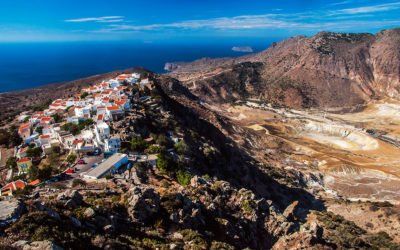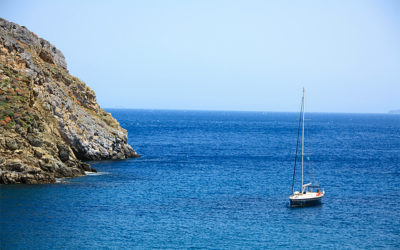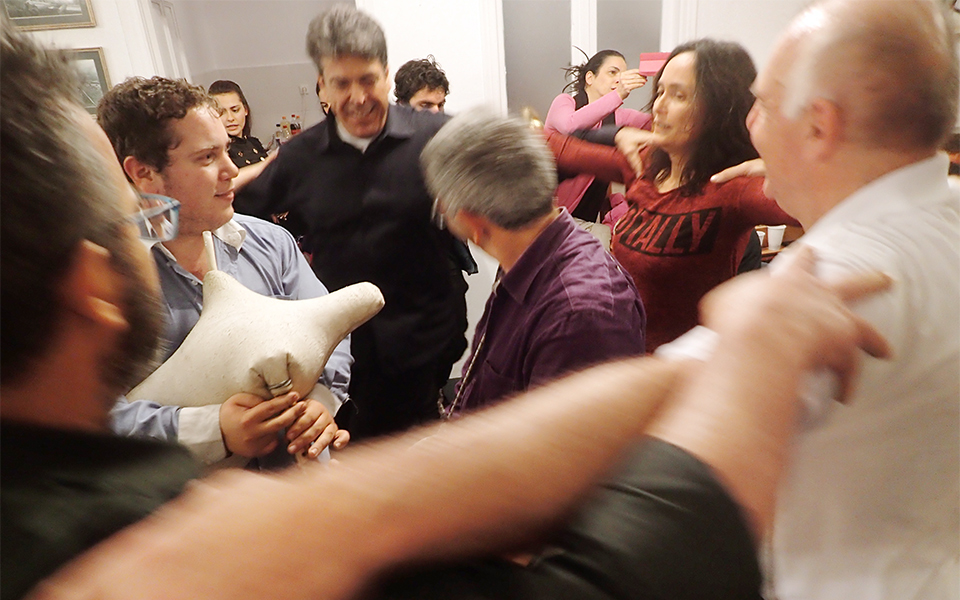
Destinations
So, You Think You Can Dance…
As an international destination for exuberance, Mykonos always had a native advantage. It’s not as though the jet set came in and superimposed music and dance on an island of quiet shepherds and weavers. There are of course still shepherds and weavers – they’re just not quiet. There are few places in Greece where dance is more central to life than on Mykonos, few places where it finds a more ecstatic expression.
Dimitra Nazou is the first to share this with me. I meet her at Lena’s House, a unique museum of life on the island, hoping to learn whatever she wishes to tell me. It’s not hard facts I am interested in, so much as the intangible – the island’s very rhythm. And I get more than I hoped for. Dimitra is brimming with images of true Mykonos – the dishes, the festivals, the arts. But nothing so lights up her fine features as talk of dance.
“My husband grew up on Delos – there were only about ten children on the island. His mother insisted he learn to dance, and dance well. For the children of Delos, dance symbolized culture, refinement.” More than culture, dance is joy itself, Dimitra tells me. “My mother-in-law would ask us if we’d had a good time when we went somewhere. We would say it was a fine time, tell her who we saw, what there was to eat and drink, but she’d just wave it away. Yes, yes. But was there dancing? If we said it wasn’t a dance, then she’d say, how do you call it a good time if there wasn’t any dancing?!”
What do Mykonians dance to? On a terraced island crowded with sheep and goats, horns and stomachs are easy to come by, the basic components of a tsambouna – a traditional bagpipe. A tsambounia (accent on the last syllable) is an evening of music and dance. As Dimitra and I talk, it occurs to her that there will be one in the highland village of Ano Mera on Friday evening, and how fortunate(!) I can experience it for myself.
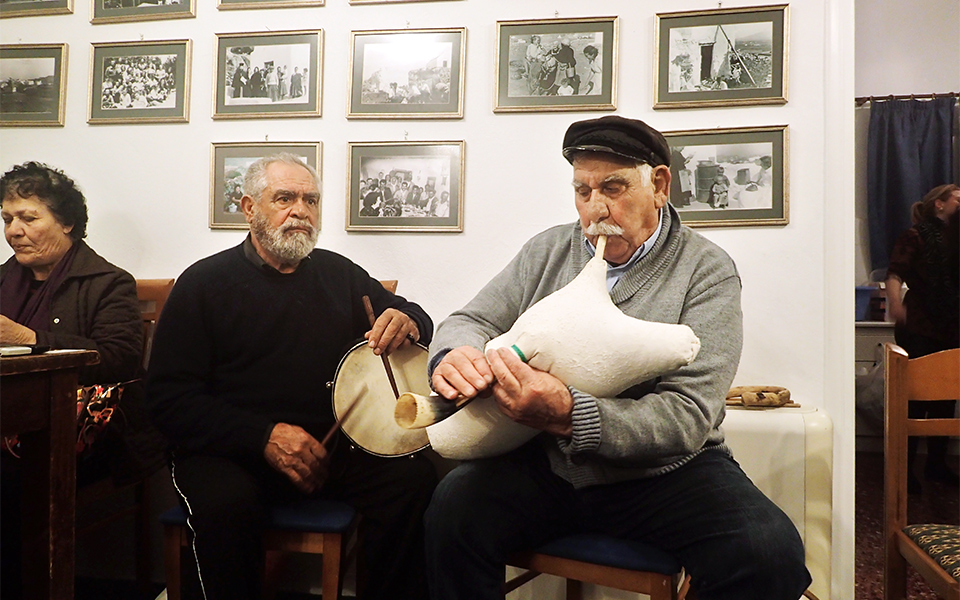
This would be good news, were I not scheduled to leave that same morning. Dimitra says that’s a shame. She says it more than once, and with true regret – not just to be polite. It really is a shame. But Mykonos inspires spontaneity – the simplest solution is just to take my non-refundable plane ticket and toss it in the trash, which I eventually do. The island easily has its way with me (I doubt I’m the first).
Just as dance has always been central here, the sensuality and abandon we have come to associate with a Mykonos summer is also not an import. Sex and dance here seem to be ever in the same breath. “Two things make life beautiful. Dance is one of them,” says Yiannis Skagias, the leader of Mykonos’s dance society.
In the crowded community center where the tsambounia is in full swing, we are the only outsiders. A shepherd, Vassilis, welcomes us to his crowded table, and Yiannis spots us from the dance floor soon after. His opening remark, perhaps saucy to a foreign ear, is not improper – the physical necessity of dance, the inevitability almost, is expressed with reverence. It’s also expressed universally; dance here is frequently placed “second only to erotic love.”
“Don’t they say it’s better to die divorced than unmarried?” begins one woman. “Being with another person – you should experience that in your life. Dance is the same. To be fulfilled in life, you must dance.”
Yes, we must dance… eventually; the tsambounia will not be ending any time soon. We’ll eat a bit first, to prepare for drinking, and drink, to prepare for dancing. There are shots of ouzo and rusk with tomato paste and capers. It’s Lent on a devout island and most of the food on the table is nistisima – no meat, no dairy. Vassilis looks for a fork to eat the fava – a puree of yellow split peas. “Fork?” his friend asks, “Scoop it up with an onion. Who uses a fork?!”
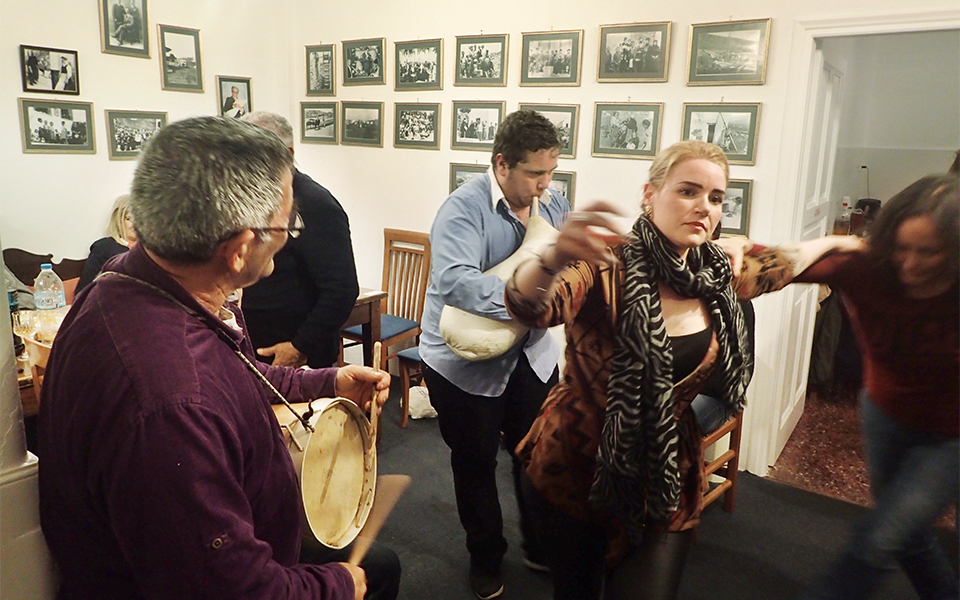
The oldest residents are seated at the best table: in the far corner, beneath black and white photographs of evenings just like this, and right next to the musicians. Local tsambouna legend ‘Babellis‘, a man in his 80’s, has the lungs of a man a fourth his age. There is also a drum and a bouzouki played by a young man. The tsambouna is not just for older Mykononians: two players tonight are both in their 30’s, and one of them crafts the instruments himself. The dancers are of every age.
After an hour to absorb the rhythm, the dance is looking less daunting. Yiannis gives me a primer, “We have five main dances in Mykonos, the Balaristos, the Syrtos, the Sousta, the Balos, and the Kalamatianos, one of the classic dances of all Greece. The Balaristos is only in Mykonos, and usually just danced by men.” Then we practice: the step is a simple: left then right, two shallow steps almost in place, a stride forward left, then the right foot forward to meet it. Once you get it, you get it, but keeping it as the dance heats up is another matter. And it really heats up. Soon one of the musicians, can no longer keep still. He is now playing the tsambouna as he kneels on the floor, enclosed tightly by our circle of five dancers, hands on each others’ shoulders. When the circle widens, the drummer joins him. My stamina breaks, and I return, exhilarated and reeling, to the table. No one else has so much as a bead of sweat on his brow.
A young woman, finally flushed, joins me after a while. She is elegant, perhaps the most expressive of the dancers, never missing beat. I thank her for including me and she says the pleasure is all hers, adding, “There is nothing better than sharing the joy of dance.” Marianna is from Arta, she tells me. She teaches the 4th grade here and she has been dancing since she was six.
“Dance is the expression of our feelings, our history, our culture.” She knows the culture of dance all over Greece. Is there anything special about dance in Mykonos? “Yes. Here, dance is even more central; here, it’s essential.” Yiannis, taking a break to wet his lips, is more succinct: “Dance or die” he says, his eyes all life. “Dance, or die!”


